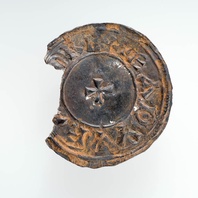
Viking Objects
Edward the Elder Penny (CM.615-1998)
A Horizontal type (HC1) silver penny of Edward the Elder (874-924), son of Alfred the Great, and minted by a moneyer called Beornwald. This coin was part of a hoard of twelve coins found at Thurcaston between 1992 and 2000. The coins are Anglo-Saxon, Arabic and Viking issues, and show the diverse and wide-ranging contacts between societies at this time. The hoard was probably deposited c.923-925, approximately five years after Leicester had been retaken by Mercia (c.918). They indicate that a bullion economy was still operating in the Danelaw as late as the 920s. This suggests that the reconquest did not immediately manage to institute Anglo-Saxon practices such as a monetary economy.
Read More
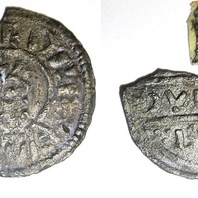
Viking Objects
Coin of Burghred of Mercia (1989-58/3650)
A silver penny of Burghred of Mercia, found in the mass grave at Repton, minted by the moneyer Dudwine. Dudwine may be the same moneyer who was minting coins for Alfred the Great at a later date. Burghred was king of Mercia from 852-874 CE. He was driven out of Mercia by the Vikings during their march from Lindsey to Repton in 874 after they sacked Tamworth. Burghred fled to Rome, where he eventually died, and was replaced by Ceowulf II who was loyal to the Vikings. Minting coins was a way of controlling the means of exchange within a kingdom and which created a more easily administered standardized system of trade. Moreover, the coins themselves were often used as propaganda, portaying symbols and statements that gave off a desired message. The Vikings later used the minting of coins to legitimize their own rule.
Read More
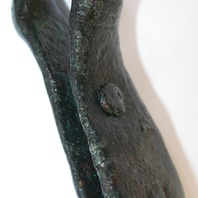
Viking Objects
Suspension Loop (1985/225-1)
This copper-alloy suspension loop was found in Mound 1 at Heath Wood, Ingleby and was probably part of a sword belt. The loop is wide enough for a doubled strap to pass through, so it may have been used to suspend the scabbard from the belt. It has been suggested that this one was probably Anglo-Saxon in origin, because this style is not known from Scandinavia, but that did not stop a Viking acquiring it and being buried with it.
Read More
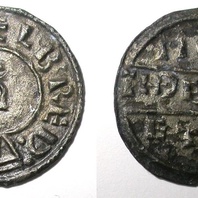
Viking Objects
Coin of Alfred the Great (1989-58/3386)
A silver penny of Alfred the Great, found in the mass grave at Repton, was minted by a moneyer called Tidhelm in London. Alfred was King of Wessex from 871 to 899 and spent most of his reign fighting off Viking invasions. He won a decisive victory at the Battle of Edington in 878 which resulted in a peace with the Vikings and the creation of the Danelaw. Minting coins was a way of controlling the means of exchange within a kingdom and which created a more easily administered standardized system of trade. Moreover, the coins themselves were often used as propaganda, portraying symbols and statements that gave off a desired message. The Vikings later used the minting of coins to legitimize their own rule.
Read More
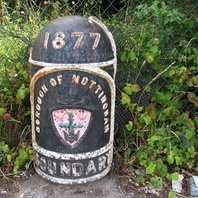
Viking Names
Nottingham
Nottingham is one of the Five Boroughs of the Danelaw. The place-name is comprised of three Old English elements: the male personal name Snot, ingas ‘people of, the people called after’ and ham ‘a village, a village community, a manor, an estate, a homestead’. Thus the name means ‘Homestead/village of Snot’s people’. It is likely that the same man or people gave his name to the adjacent Sneinton. There is an older British name for Nottingham, Tigguocobauc ‘house of caves, cavy house’, alluding to the sandstone caves of Castle Hill. However, there is no other record for this name outside of Asser’s reference for 868. According to the Anglo-Saxon Chronicle, Nottingham was occupied by the Great Heathen Army in 867 and remained under Scandinavian control until 918, when it was occupied by Edward the Elder. The influence of these Vikings can be seen in the city of Nottingham’s street names. The Old Norse element gata ‘path, way, road’ can be found in street names such as Barker Gate ‘street of the barkers or tanners’, Castle gate ‘street leading to the castle’, and Fisher Gate ‘street of the fishermen’.
Read More
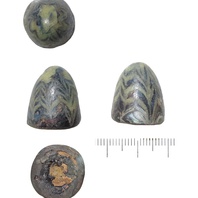
Viking Objects
Glass Gaming Piece (LIN-C31CD7)
There are different possible interpretations of this Lincolnshire find from 2012. It could be a playing-piece as interpreted in the reproductions. Anglo-Saxon playing-pieces of shaped animal tooth are of similar dimensions, while glass counters were used both in the Roman period and taller glass playing men in the Viking period. This find is however considered by some archaeologists more likely to be a decorative setting from fine metalwork. The rather muddy glass colours suggest that the glasses used had already been recycled, and the clay core indicates careful use of a precious resource as well as a means of moulding on a decorated sheet of glass. The best parallels for this find, though none matches the form, are the oval cabochon pieces of dark blue and opaque white glass from the Anglo-Saxon monastery at Monkwearmouth, County Durham. Prominent coloured glass inlays are a part of the Insular tradition with its roots in Ireland. In Irish work the emphasis is on contrasting coloured zones and inlays, technically more complex and in a diverging tradition from this new find, though imitated elsewhere in English work.
Read More
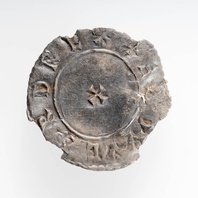
Viking Objects
Edward the Elder Penny (CM.616-1998)
A silver Horizontal type (HT1) penny of Edward the Elder (c. 874-924) minted in London by Garead. Edward was the son of Alfred the Great and succeeded him as king of Wessex. This coin was part of a hoard of twelve coins found at Thurcaston between 1992 and 2000. The coins are Anglo-Saxon, Arabic and Viking issues, and show the diverse and wide-ranging contacts between societies at this time. The hoard was probably deposited c.923-925, approximately five years after Leicester had been retaken by Mercia (c.918). They indicate that a bullion economy was still operating in the Danelaw as late as the 920s. This suggests that the reconquest did not manage to institute Anglo-Saxon practices such as a monetary economy immediately.
Read More
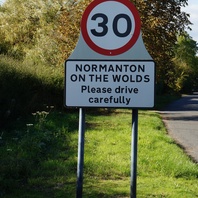
Item
Normanton on the Wolds
Normanton on the Wolds, in the Bingham Wapentake of Nottinghamshire, takes its name from the Old English ethnonym Norðman ‘Northman, Norwegian’ and the Old English element tun ‘farm, settlement’. There are several places of this name, predominantly in the East Midlands: five in Nottinghamshire, one each in Derbyshire, Leicestershire, Lincolnshire and Rutland, and one in the West Riding of Yorkshire. Traditionally, the place-name has been interpreted as referring to a settlement of Norwegians (in an area where most of the Scandinavian settlers were Danes). However, the exact implications of such a name are not yet fully understood and are the subject of ongoing work by Dr Jayne Carroll of the Institute for Name-Studies, University of Nottingham.
Read More
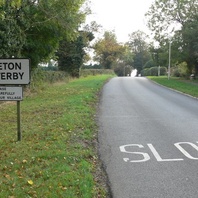
Viking Names
Smeeton Westerby
Smeeton Westerby, in the Gartree Hundred of Leicestershire, was originally two separate settlements. The earlier settlement is Smeeton which comes from Old English smið ‘smith, a worker in metal’ and Old English tun ‘an enclosure; a farmstead; a village; an estate’. The later settlement, Westerby, is a Scandinavian compound from Old Norse vestr ‘west, westerly’ and Old Norse by ‘a farmstead, a village’. Westerby is presumably an offshoot of Smeeton as the name refers to its location being slightly to the west of Smeeton.
Read More
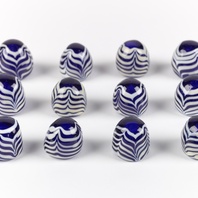
Viking Objects
Reproduction Glass Gaming Pieces
These are reproductions of a conical glass stud found in Lincolnshire, interpreted here as gaming pieces. However analysis of the original on which they are modelled suggests that it could also have been a glass fitting on decorative metalwork.
Read More
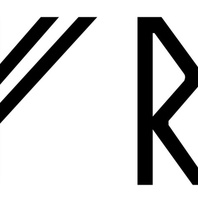
Viking Names
Alfrun
Alfrún was recorded in West Scandinavia (Norway and Iceland) as a mythological name. It is an Old Norse compound formed from the elements Alf- ‘elf’ and –rún ‘confidante’. It has been suggested that when used in a personal name it has the sense of ‘secret, wisdom’, associated with rúnar ‘runes’. There may be one attestation of Alfrún in a medieval church document from Lincolnshire. However, the form may alternatively represent the Old English female personal name, Ælfrūn.
